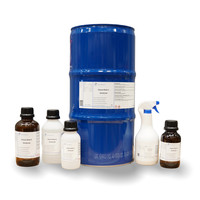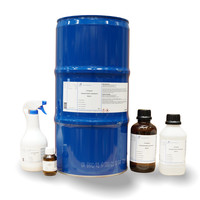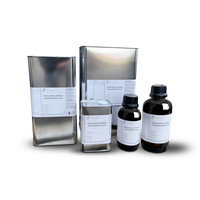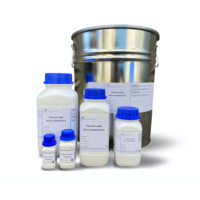You have no items in your shopping cart
Ammonia 25%, pure
- Buy 2 and save 5%
- Buy 6 and save 10%
What is Ammonia?
Ammonia or Ammonia when dissolved in water. is a chemical compound of nitrogen and hydrogen with the empirical formula NH3. It is a colorless, water-soluble and poisonous gas with a strong pungent odor that causes tears and is suffocating. Ammonia is an amphoteric substance: it acts as a base under watery conditions. It forms different series of salts: both the cationic ammonium salts and the anionic amides, imides and nitrides in which one (amide), two (imides) or all (nitrides) protons (hydrogen ions) have been replaced by metal ions.
Ammonia is one of the most commonly produced chemicals and a basic material for the production of all other nitrogen compounds. Most ammonia is processed into fertilizers, especially urea and ammonium salts. So far (2020) it has been almost exclusively produced using the Haber-Bosch process from the elements hydrogen and nitrogen.
Biologically, ammonia has an important function as an intermediate in the formation and breakdown of amino acids. Due to the toxicity of larger amounts of ammonia, it is converted into non-toxic urea or, for example, in birds, uric acid for excretion in the body.
Applications
-Basic material for the production of all other industrially produced nitrogenous compounds
With a share of 40% in 1995, urea is the main compound produced from ammonia, which is mainly used as fertilizer and for the production of urea resins; Urea is obtained by reacting ammonia with carbon dioxide.
In addition to urea, other nitrogenous fertilizers are also made from ammonia. The most important are the ammonium salts ammonium nitrate, phosphate and sulphate. In total, the share of fertilizers in the total ammonia consumption in 2003 was 83%.
Another important substance made from ammonia is nitric acid, which in turn is the raw material for many other compounds. In the Ostwald process, ammonia reacts with oxygen on platinum meshes to form nitrogen oxides, which react with water to form nitric acid.
-Role in various organic syntheses
Primary carboxamides can be obtained from ammonia and suitable carboxylic acid derivatives such as carboxylic acid chlorides or esters. In contrast, the direct reaction of carboxylic acid and ammonia to form the corresponding amide occurs only at elevated temperatures when the previously formed ammonium salt decomposes. A technically important reaction is that of adipic acid and ammonia to form adipic dinitrile. This is further hydrogenated to hexamethylenediamine, making it an intermediate for nylon fabrication.
It is possible to produce aniline by the reaction of phenol and ammonia on an aluminum silicate catalyst. However, this synthetic route requires more energy and has a lower yield than the synthesis and reduction of nitrobenzene and is therefore only used to a limited extent when phenol is cheaply available.
-Special applications
The reaction of ammonia with acids is used in flue gas cleaning. It is able to react with sulfuric acid and nitric acid and thus removes unwanted, environmentally harmful sulfur and nitrogen oxides from the flue gas.
Due to its high specific evaporation enthalpy of 1368 kJ / kg, ammonia is also used as a refrigerant. Advantages are low flammability, the non-existent contribution to the greenhouse effect or the destruction of the ozone layer and the application range of −60 to +100 ° C. The toxicity of the compound is detrimental.
Ammonia solution is also used in olfactory ampoules. The extreme odor stimulus serves as an anti-dissociative strategy, for example in the context of dialectical behavioral therapy.
Ammonia reacts with the tannic acid found in wood and turns the wood dark brown depending on the concentration of the tannic acid. Oak wood, for example, is transformed with ammonia or sal ammoniac to dark brown smoked oak. Ammonia is also used for coloring in the production of blueprints (diazotypes).
There are also experimental fuel cell systems in which the necessary hydrogen is obtained when it is needed by splitting the ammonia using chemical processes. Another approach that has been explored is to use ammonia as an easy-to-handle chemical energy storage device, for example to store excess electricity from fluctuating renewable energy sources (wind and solar) on a long-term and industrial scale, in order to to close gaps in the supply of these energies and to use renewable energy sources for vehicle propulsion, for example in marine engines. Due to the efficiency of approx. 55-60% in converting electrical energy into chemical energy from ammonia and back into large diesel
Buy ammonia?
Laboratory discounter sells ammonia in different packaging and for a friendly price! So you order your ammonia quickly and easily via Laboratoriumdiscounter.nl. Shipped fast!
Technical data:
Molar mass (M) 17,03 + aq g/mol
Dichtheid 0,91
Boiling point (bp) 37,7 °C
Melting point (mp)-57,5 °C
ADR 8 III • WGK 2
CAS No.[1336-21-6]
EG-Nr. 215-647-6 • UN-Nr. 2672
Downloads
$$$$$
Hazard statements
H290 May be corrosive to metals
H314 Causes severe burns and eye damage
H335 May cause respiratory irritation
H400 Very toxic to aquatic life
Safety recommendations
Precautions - prevention
P273 Avoid release to the environment.
P280 Wear protective gloves / protective clothing / eye protection / face protection.
Precautions - response
P303 + P361 + P353 IF ON SKIN (or hair): Immediately contaminate clothing
pull out. Rinse skin with water [or shower].
P305 + P351 + P338 IF IN EYES: Rinse cautiously with water for a period of time
amount of minutes; remove contact lenses, if possible; keep rinsing.
P310 Immediately call a POISON CENTER / doctor.










